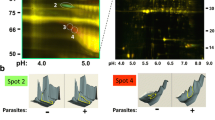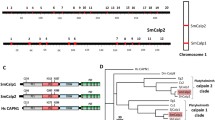Abstract
Schistosomes are parasitic worms that can live in the bloodstream of their vertebrate hosts for many years. It has been proposed that the worms impinge on host purinergic signalling by degrading proinflammatory molecules like ATP as well as prothrombotic mediators like ADP. This capability may help explain the apparent refractoriness of the worms to both immune elimination and thrombus formation. Three distinct ectoenzymes, expressed at the host-exposed surface of the worm’s tegument, are proposed to be involved in the catabolism of ATP and ADP. These are alkaline phosphatase (SmAP), phosphodiesterase (SmNPP-5), and ATP diphosphohydrolase (SmATPDase1). It has recently been shown that only one of these enzymes—SmATPDase1—actually degrades exogenous ATP and ADP. However, a second ATP diphosphohydrolase homolog (SmATPDase2) is located in the tegument and has been reported to be released by the worms. It is possible that this enzyme too participates in the cleavage of exogenous nucleotide tri- and di-phosphates. To test this hypothesis, we employed RNA interference (RNAi) to suppress the expression of the schistosome SmATPDase1 and SmATPDase2 genes. We find that only SmATPDase1-suppressed parasites are significantly impaired in their ability to degrade exogenously added ATP or ADP. Suppression of SmATPDase2 does not appreciably affect the worms’ ability to catabolize ATP or ADP. Furthermore, we detect no evidence for the secretion or release of an ATP-hydrolyzing activity by cultured parasites. The results confirm the role of tegumental SmATPDase1, but not SmADTPDase2, in the degradation of the exogenous proinflammatory and prothrombotic nucleotides ATP and ADP by live intravascular stages of the parasite.




Similar content being viewed by others
References
Vennervald BJ, Dunne DW (2004) Morbidity in schistosomiasis: an update. Curr Opin Infect Dis 17(5):439–447
Pellegrino J, Coelho PM (1978) Schistosoma mansoni: wandering capacity of a worm couple. J Parasitol 64(1):181–182
Bloch EH (1980) In vivo microscopy of schistosomiasis. II. Migration of Schistosoma mansoni in the lungs, liver, and intestine. AmJTrop Med Hyg 29(1):62–70
Smith JH, von Lichtenberg F (1974) Observations on the ultrastructure of the tegument of Schistosoma mansoni in mesenteric veins. AmJTrop Med Hyg 23(1):71–77
Hanley PJ, Musset B, Renigunta V, Limberg SH, Dalpke AH, Sus R, Heeg KM, Preisig-Muller R, Daut J (2004) Extracellular ATP induces oscillations of intracellular Ca2+ and membrane potential and promotes transcription of IL-6 in macrophages. Proc Natl Acad Sci U S A 101(25):9479–9484
Lohman AW, Billaud M, Isakson BE (2012) Mechanisms of ATP release and signalling in the blood vessel wall. Cardiovasc Res 95(3):269–280. doi:10.1093/cvr/cvs187
Bours MJ, Swennen EL, Di Virgilio F, Cronstein BN, Dagnelie PC (2006) Adenosine 5'-triphosphate and adenosine as endogenous signaling molecules in immunity and inflammation. Pharmacol Ther 112(2):358–404
Yegutkin GG (2008) Nucleotide- and nucleoside-converting ectoenzymes: important modulators of purinergic signalling cascade. Biochim Biophys Acta 1783(5):673–694. doi:10.1016/j.bbamcr.2008.01.024
Bhardwaj R, Skelly PJ (2009) Purinergic signaling and immune modulation at the schistosome surface? Trends Parasitol 25(6):256–260. doi:10.1016/j.pt.2009.03.004
Vasconcelos EG, Nascimento PS, Meirelles MN, Verjovski-Almeida S, Ferreira ST (1993) Characterization and localization of an ATP-diphosphohydrolase on the external surface of the tegument of Schistosoma mansoni. Mol Biochem Parasitol 58(2):205–214
Vasconcelos EG, Ferreira ST, Carvalho TM, Souza W, Kettlun AM, Mancilla M, Valenzuela MA, Verjovski-Almeida S (1996) Partial purification and immunohistochemical localization of ATP diphosphohydrolase from Schistosoma mansoni. Immunological cross-reactivities with potato apyrase and Toxoplasma gondii nucleoside triphosphate hydrolase. J Biol Chem 271(36):22139–22145
Da'dara AA, Bhardwaj R, Ali YB, Skelly PJ (2014) Schistosome tegumental ecto-apyrase (SmATPDase1) degrades exogenous pro-inflammatory and pro-thrombotic nucleotides. Peer J 2:e316. doi:10.7717/peerj.316
Mahaut-Smith MP, Ennion SJ, Rolf MG, Evans RJ (2000) ADP is not an agonist at P2X(1) receptors: evidence for separate receptors stimulated by ATP and ADP on human platelets. Br J Pharmacol 131(1):108–114. doi:10.1038/sj.bjp.0703517
Gachet C (2006) Regulation of platelet functions by P2 receptors. Annu Rev Pharmacol Toxicol 46:277–300
Joseph M, Auriault C, Capron A, Vorng H, Viens P (1983) A new function for platelets: IgE-dependent killing of schistosomes. Nature 303(5920):810–812
Levy MG, Read CP (1975) Purine and pyrimidine transport in Schistosoma mansoni. J Parasitol 61(4):627–632
Levy MG, Read CP (1975) Relation of tegumentary phosphohydrolase to purine and pyrimidine transport in Schistosoma mansoni. J Parasitol 61(4):648–656
Levano-Garcia J, Mortara RA, Verjovski-Almeida S, DeMarco R (2007) Characterization of Schistosoma mansoni ATPDase2 gene, a novel apyrase family member. Biochem Biophys Res Commun 352(2):384–389
Braschi S, Curwen RS, Ashton PD, Verjovski-Almeida S, Wilson A (2006) The tegument surface membranes of the human blood parasite Schistosoma mansoni: a proteomic analysis after differential extraction. Proteomics 6(5):1471–1482. doi:10.1002/pmic.200500368
Braschi S, Wilson RA (2006) Proteins exposed at the adult schistosome surface revealed by biotinylation. Mol Cell Proteomics MCP 5(2):347–356. doi:10.1074/mcp.M500287-MCP200
Skelly PJ, Da'dara A, Harn DA (2003) Suppression of cathepsin B expression in Schistosoma mansoni by RNA interference. Int J Parasitol 33(4):363–369
Hackett F (1993) The culture of Schistosoma mansoni and production of life cycle stages. In: Hyde JE (ed) Protocols in Molecular Parasitology. Humana Press Inc., Totowa, pp 89–99
Krautz-Peterson G, Radwanska M, Ndegwa D, Shoemaker CB, Skelly PJ (2007) Optimizing gene suppression in schistosomes using RNA interference. Mol Biochem Parasitol 153(2):194–202
Ndegwa D, Krautz-Peterson G, Skelly PJ (2007) Protocols for gene silencing in schistosomes. Exp Parasitol 117(3):284–291
Krautz-Peterson G, Simoes M, Faghiri Z, Ndegwa D, Oliveira G, Shoemaker CB, Skelly PJ (2010) Suppressing glucose transporter gene expression in schistosomes impairs parasite feeding and decreases survival in the mammalian host. PLoS Pathog 6(6):e1000932. doi:10.1371/journal.ppat.1000932
Livak KJ, Schmittgen TD (2001) Analysis of relative gene expression data using real-time quantitative PCR and the 2−ΔΔCt Method. Methods 25(4):402–408. doi:10.1006/meth.2001.1262
Krautz-Peterson G, Radwanska M, Ndegwa D, Shoemaker CB, Skelly PJ (2007) Optimizing gene suppression in schistosomes using RNA interference. Mol Biochem Parasitol Notes 153(2):194–202
Hall SL, Braschi S, Truscott M, Mathieson W, Cesari IM, Wilson RA (2011) Insights into blood feeding by schistosomes from a proteomic analysis of worm vomitus. Mol Biochem Parasitol 179(1):18–29. doi:10.1016/j.molbiopara.2011.05.002
DeMarco R, Kowaltowski AT, Mortara RA, Verjovski-Almeida S (2003) Molecular characterization and immunolocalization of Schistosoma mansoni ATP-diphosphohydrolase. Biochem Biophys Res Commun 307(4):831–838
Abeijon C, Yanagisawa K, Mandon EC, Hausler A, Moremen K, Hirschberg CB, Robbins PW (1993) Guanosine diphosphatase is required for protein and sphingolipid glycosylation in the Golgi lumen of Saccharomyces cerevisiae. J Cell Biol 122(2):307–323
Braun N, Fengler S, Ebeling C, Servos J, Zimmermann H (2000) Sequencing, functional expression and characterization of rat NTPDase6, a nucleoside diphosphatase and novel member of the ecto-nucleoside triphosphate diphosphohydrolase family. Biochem J 351(Pt 3):639–647
Knowles AF (2009) The single NTPase gene of Drosophila melanogaster encodes an intracellular nucleoside triphosphate diphosphohydrolase 6 (NTPDase6). Arch Biochem Biophys 484(1):70–79. doi:10.1016/j.abb.2009.01.005
Mendes RG, Gusmao MA, Maia AC, Detoni Mde L, Porcino GN, Soares TV, Juliano MA, Juliano L, Coelho PM, Lenzi HL, Faria-Pinto P, Vasconcelos EG (2011) Immunostimulatory property of a synthetic peptide belonging to the soluble ATP diphosphohydrolase isoform (SmATPDase 2) and immunolocalisation of this protein in the Schistosoma mansoni egg. Mem Inst Oswaldo Cruz 106(7):808–813
Bermudes D, Peck KR, Afifi MA, Beckers CJ, Joiner KA (1994) Tandemly repeated genes encode nucleoside triphosphate hydrolase isoforms secreted into the parasitophorous vacuole of Toxoplasma gondii. J Biol Chem 269(46):29252–29260
Berredo-Pinho M, Peres-Sampaio CE, Chrispim PP, Belmont-Firpo R, Lemos AP, Martiny A, Vannier-Santos MA, Meyer-Fernandes JR (2001) A Mg-dependent ecto-ATPase in Leishmania amazonensis and its possible role in adenosine acquisition and virulence. Arch Biochem Biophys 391(1):16–24. doi:10.1006/abbi.2001.2384
de Jesus JB, de Sa Pinheiro AA, Lopes AH, Meyer-Fernandes JR (2002) An ectonucleotide ATP-diphosphohydrolase activity in Trichomonas vaginalis stimulated by galactose and its possible role in virulence. Z Naturforsh C J Biosci 57(9–10):890–896
Zaborina O, Li X, Cheng G, Kapatral V, Chakrabarty AM (1999) Secretion of ATP-utilizing enzymes, nucleoside diphosphate kinase and ATPase, by Mycobacterium bovis BCG: sequestration of ATP from macrophage P2Z receptors? Mol Microbiol 31(5):1333–1343
Punj V, Zaborina O, Dhiman N, Falzari K, Bagdasarian M, Chakrabarty AM (2000) Phagocytic cell killing mediated by secreted cytotoxic factors of Vibrio cholerae. Infect Immun 68(9):4930–4937
Thammavongsa V, Kern JW, Missiakas DM, Schneewind O (2009) Staphylococcus aureus synthesizes adenosine to escape host immune responses. J Exp Med 206(11):2417–2427. doi:10.1084/jem.20090097
Melnikov A, Zaborina O, Dhiman N, Prabhakar BS, Chakrabarty AM, Hendrickson W (2000) Clinical and environmental isolates of Burkholderia cepacia exhibit differential cytotoxicity towards macrophages and mast cells. Mol Microbiol 36(6):1481–1493
Acknowledgments
This work was supported by grant AI-056273 from the NIH-NIAID. Infected snails were provided by BRI via the NIAID schistosomiasis resource center under NIH-NIAID Contract No. HHSN272201000005I.
Author information
Authors and Affiliations
Corresponding author
Additional information
Akram A. Da’dara and Rita Bhardwaj contributed equally to this work.
Rights and permissions
About this article
Cite this article
Da’dara, A.A., Bhardwaj, R. & Skelly, P.J. Schistosome apyrase SmATPDase1, but not SmATPDase2, hydrolyses exogenous ATP and ADP. Purinergic Signalling 10, 573–580 (2014). https://doi.org/10.1007/s11302-014-9416-5
Received:
Accepted:
Published:
Issue Date:
DOI: https://doi.org/10.1007/s11302-014-9416-5




